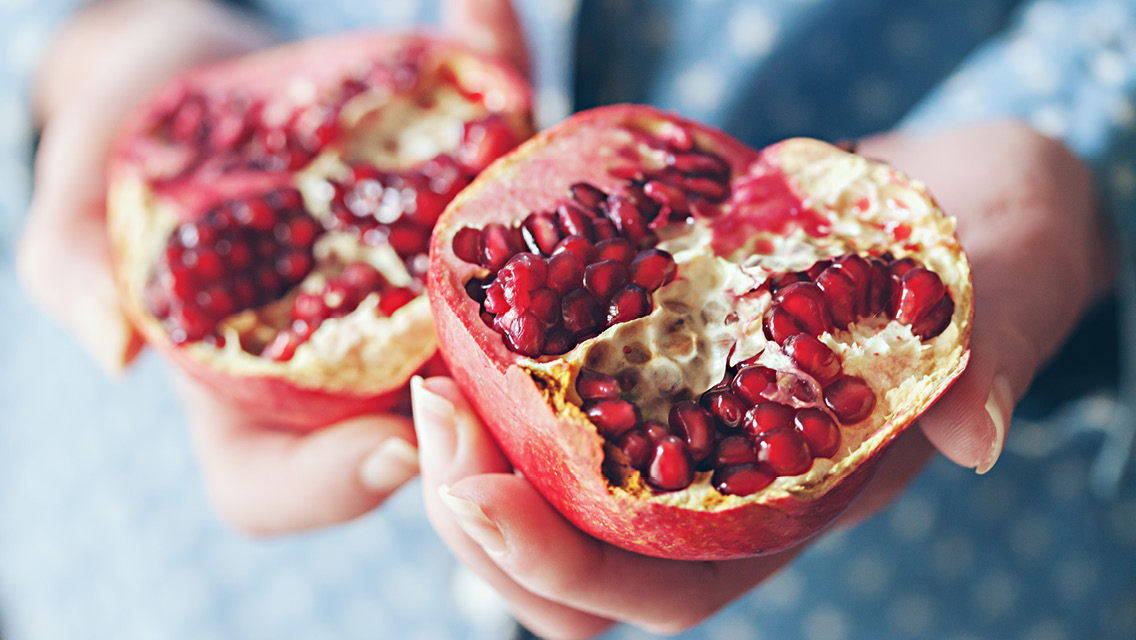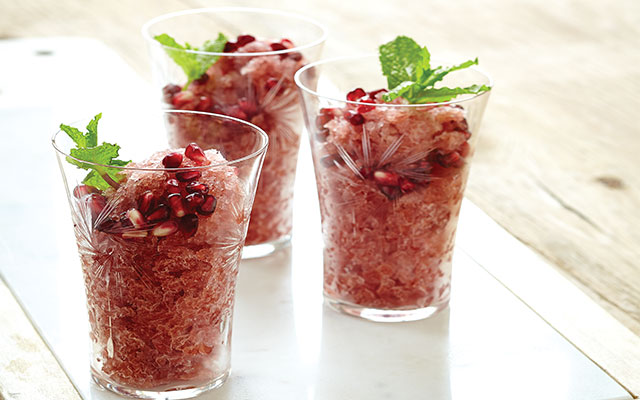The pomegranate has gotten a bad rap for being among the most labor-intensive of fruits to open and eat, but that’s an unfair knock against this delectable, nutrient-rich fruit. The pomegranate is sought after for its seeds, which are revered for their luscious sweet and tart flavors. Pomegranate juice, which is extracted from the seeds, is readily available in stores and has been embraced by millions of Americans for its great taste and health-bestowing benefits. Whether raw, juiced or cooked, pomegranates make a versatile, delicious and healthy addition to any meal.
Food Basics
The pomegranate grows on shrubby trees native to western Asia and the Mediterranean. While the most prized varieties are still grown in Iran and Turkey, in the United States, pomegranates are grown primarily in California and are available from October to January. Between the size of an orange and a grapefruit, with leathery skin that ranges from brownish red to pinkish yellow, the pomegranate is filled with edible seeds separated by a cream-colored membrane. The seeds are encased in juicy crimson sacs that can be super tart or sweet, depending on the variety. Choose fresh pomegranates that are round, heavy and firm. Avoid fruit with cracked skin – a sign it is overripe.
Nutritional Know-How
A real superfood, pomegranates are low in calories, rich in potassium and vitamin C, and high in fiber. They also boast more cancer-fighting phytochemicals and anti-aging antioxidants than cranberries, green tea, grapes or red wine. Moreover, a number of published studies suggest that the pomegranate can support heart health by reducing bad cholesterol (LDL), blood pressure, arterial plaques and other factors that play a role in cardiovascular disease. (To reference studies and analyses of health benefits, visit www.webmd.com and search on “Pomegranate.”)
Kitchen Basics
- To open a pomegranate: Cut off the crown, score the rind into quarters and submerge in a large bowl of cold water. Using both hands, break open sections of the fruit under water and roll out the seeds. The seeds will sink to the bottom of the bowl, and the membrane will float to the top.
- To extract juice: Place pomegranate seeds in a strainer or colander and gently press with the back of a kitchen spoon.
- Pomegranates can be stored whole in the coldest part of the refrigerator for up to two months. Seeds can be frozen in an airtight container for up to a year.
Eat Up!
Pomegranate seeds are great sources of flavor and energy. The night before a workout, a hike or a long day at work, pop a pomegranate in the freezer. The next day, take it with you. When you’re ready for a refreshing treat, roll and press the pomegranate against your leg to loosen the seeds. Peel back the outer skin and the seeds will roll out into your hands. No longer frozen, but still cold, the seeds offer a burst of sweet juices.
Of course, this brightly colored beauty can also be served up in a variety of other ways:
- Sprinkle raw seeds on fruit and green salads.
- Season a roast chicken from the inside out by stuffing seeds in the cavity prior to roasting.
- Substitute pomegranate juice for water or stock when making couscous.
- Blend pomegranate juice with fruits or teas to make smoothies or refreshing spritzers.
- Freeze juice in ice-cube trays for extra-flavorful smoothies.
- Make a glaze for turkeys or hams by warming the juice over medium heat. Add a bit of sugar and water and continue to heat until the volume of juice has reduced by half.
- Mix a handful of seeds into hummus for a delectable sweet-and-savory mix.
This article has been updated. It originally appeared online on November 1, 2006.




This Post Has 0 Comments